Theology
Timothy Wardle
The Jerusalem Temple and Early Christian Identity
[Der Tempel in Jerusalem und die frühchristliche Identität.]
Also Available As:
Published in English.
In this volume, Timothy Wardle examines the central importance of the Jerusalem Temple during the Second Temple period and the motivating factors which led to the construction of several rival Jewish temples to that in Jerusalem: namely, the Samaritan Temple on Mount Gerizim, the Oniad Temple in Leontopolis, and the »temple of men« at Qumran. Building upon these findings, Wardle then explores the early Christian decision to describe their own community in terms befitting a temple. He argues that the formation of a nascent Christian temple identity stretches back to the earliest layers of the Jewish-Christian community in Jerusalem, and that, in line with the Samaritan, Oniad, and Qumran communities, this distinctive temple ideology was predicated upon an acrimonious relationship with the priestly leadership charged with oversight of the Jerusalem Temple.
